KZN Districts
- uThungulu
Overview
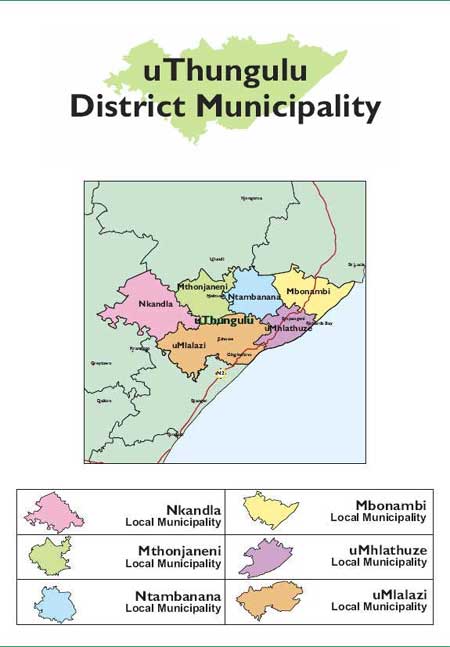
This is the second largest populated district in KZN. Richards Bay and Empangeni are economic centres of this district. Richards Bay has a very large scale of industrialisation due to the harbour. The port of Richards Bay is situated in this area as it makes this district a gateway to other economic hubs of KZN through rail and road. Richards Bay port is the largest deep-water port on the African continent. It imports the highest volume of bulk cargo of all African ports and has double the capacity of the port of Durban, handling in excess of 75 million tons of cargo annually. Economically this district is the second largest contributor to the provincial GGP after eThekwini District, standing at 7%. Statistically there are 885 966 people living in this distric.
Sectors
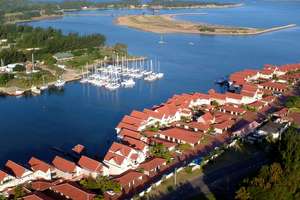
Manufacturing Sector
In Mthonjaneni there are a predominantly small scale ventures while Mbonambi is dominated by Sappi, Mondi and RBM manufacturing industries. Metals and related products are the biggest industries in the districts contributing more than 40% to the district economy followed by the petroleum, rubber, plastics and chemical industries which contributes 18% and the wood, paper and printing industry that contributed 13%. The manufacturing of food, beverages and tobacco products, transport equipment products, and furniture products, contributed more than R350 million each to the uThungulu economy in 2004. The prospects of IDZ in uThungulu represent opportunities for manufacturing goods targeting the local and global economies.
Agricultural Sector
The agricultural activities in the districts are mainly sugar cane and forestry with some citrus, nuts and animal husbandry. Mbonambi area is comprised of small scale of agriculture mostly subsistence farming, community gardens and forestry. Small scale of vegetables and poultry, sugar and timber is found along the areas of Umhlathuze, while Ntambanana has a mixed agricultural productivity that consist of large scale of commercial farming, small scale of poultry, vegetables and cotton. Umlalazi is more concentrating on sugar cane, timber, citrus and community gardens. Small groups of farmers are emerging in this local municipal area. Development of this sector in Umlalazi is hindered by lower skills level, poor transport infrastructure and limited market access. Major crop production found in Mthonjaneni includes agronomy (maize, potato & beans), horticulture (cabbage, chilies & tomatoes), fruits mainly banana, avocado and citrus fruits. Forestry plantations are found in around areas of Nkandla local municipality together with subsistence farming (maize, beans, vegetables and small livestock), essential oil production and also tea production that is located at the Ntingwe tea estate.
Port Services Sector
As the third most important town in KZN, Richards Bay boasts the presence of the port of Richards Bay. The harbour is the second largest export coal terminal in the world. The potential of this harbour to expand given its land area of 2.157 hectares and 1.495 hectares of water area will make this port one of the largest ports in the world. Given the current expansion project run by Richards Bay Coal Terminal Company limited, this will see the coal terminal's capacity expanded from current 72 million tons per annum to 81 million tons per annum. More job opportunities are to derive from this project in a form of supply services and coal mining activities within the vicinity of Richards Bay.
Tourism Sector
The current status of tourism within uThungulu has bee found to be relatively weak, with the exception of
business tourists related to the industrial strengths of Richards Bay area. Research has shown that neither
foreign nor domestic tourists presently see uThungulu district as a ''tourism destination''. However market
research has identified that potential does exist to develop some of the areas inherent tourism assets and to
embark upon a programme to develop catalytic attractions.
King Cetshwayo District Municipality
King Cetshwayo District Municipality is situated in north eastern KwaZulu-Natal and is made up of the six local
municipalities namely, uMhlatuze, Mbonambi, Ntambanana, uMlalazi, Mthonjaneni and Nkandla. The district has a
climate conducive to agriculture and tourism and has significant natural resources. Major land uses are commercial
agriculture (sugar-cane in the low-lying coastal belt and citrus vegetable and subtropical fruit in irrigated areas),
forestry, mining, traditional farming urban areas that are expanding and industrial development in the Empangeni
Richards Bay areas.
Below are packaged projects throughout uThungulu District with concise project descriptions, information on
locations, current statuses, ownership, return on investment and importantly project requirements.
Development Corridors
Spatial Development Corridor
Nodes and Development Corridors for this region for the next five years:
- SC1 - Umhlatuze/Ulundi/Vryheid (P 700) Corridor as a new link between the Richards Bay harbor and Gauteng, focusing primarily on the section between Ulundi and the Cengeni Gate of Umfolozi Game Reserve, and the Ulundi Airport.
Developmental Nodes - King Cetshwayo
DC28: Agriculture and Land Reform
| Nkwalini valley land reform beneficiaries - citrus production & processing |
| Expansion of tea production & processing in Nkandla |
| Support and expansion of land reform initiatives (e.g. Ntonjaneni land reform initiative - timber and cane production) |
| Development of agricultural potential along P700 route |
| Develop sugar cane production opportunities on land with potential on Trust land |
DC28: Tourism
| Zulu Heritage Trail |
| Cruise tourism - creation of luxury cruise liner terminal at Richards Bay Harbour |
| Forestry tourism - improve tourism opportunities related to Nkandla, Qudeni, Entumeni, Ngoye & Dlinza forests |
DC28: Industry
| Richards Bay IDZ: provide world class infrastructure, address issues related to: land ownership; designation as an IDZ; relationship with municipality and SARS; roles of province & national. |
| Empangeni industrial townships: Assist municipality to provide world class infrastructure support industrial development |
| Provide adequate affordable housing and related services |
DC28: Services
| Formalise and plan Nkandla & Ntonjaneni to position for investment |
| Provide adequate affordable housing and related services in towns |
Agrarian Revolution Target Areas (2006/7)
Finally, the Agrarian Revolution Strategy has clearly identified targeted Districts for 2006/7 which should each receive approximately R35m of Siyavuna funding . Each district will have specific targeted commodity focus areas that respond to the Provincial Agricultural Framework, areas of identified Hunger, and the priority areas identified by the Provincial Government and the Premier for 2006/7 specifically.
King Cetshwayo (Nkandla, Eshowe)
| Support expansion of Ntingwe Tea Out-grower development |
| Implement household Greening (Citrus and Peaches) projects in partnership Nkwaleni Valley commercial farmers |
| Support essential oils (Rose geranium) projects in partnership with Nkandla communities and uThungulu District |
| Establish Mushroom production and distribution sites at all hospitals and clinics with high malnutrition records and seriously low levels of child growth rates (in conjunction with Vitamin supplementation programmes) |
| Support Land Reform initiatives |
| Support Land Care and Alien Weed Control Initiatives |
Existing Investors
King Cetshwayo District Municipality is situated in north eastern KwaZulu-Natal and is made up of the six local municipalities namely, uMhlatuze, Mbonambi, Ntambanana, uMlalazi, Mthonjaneni and Nkandla. The district has a climate conducive to agriculture and tourism and has significant natural resources. Major land uses are commercial agriculture (sugar-cane in the low-lying coastal belt and citrus vegetable and subtropical fruit in irrigated areas), forestry, mining, traditional farming urban areas that are expanding and industrial development in the Empangeni Richards Bay areas.
| COMPANY NAME | SOURCE COUNTRY | WEBSITE |
|---|---|---|
| Daewoo Shipbuilding & Marine Engineering | South Korea | |
| Tata Group | India | www.tata.com |
| Sodra | Sweden | www.sodra.com |
| BHP Billiton | Aus/ Indonesia | www.bhpbilliton.com |
| Bell Equipment | SA | www.bellequipment.com |
| Richards Bay Minerals | SA | www.rbm.co.za |
| Richards Bay Coal Terminal | SA | www.rbct.co.za |
| Foskor | SA | www.foskor.co.za |
| Exxaro KZN Sands | SA | www.exxaro.com |
King Cetshwayo District
King Cetshwayo District Municipality is situated in north eastern KwaZulu-Natal and is made up of the six local municipalities namely, uMhlatuze, Mbonambi, Ntambanana, uMlalazi, Mthonjaneni and Nkandla. The district has a climate conducive to agriculture and tourism and has significant natural resources. Major land uses are commercial agriculture (sugar-cane in the low-lying coastal belt and citrus vegetable and subtropical fruit in irrigated areas), forestry, mining, traditional farming urban areas that are expanding and industrial development in the Empangeni Richards Bay areas.
King Cetshwayo District: Socio-Economic Profile
- Demographics
- The KwaZulu-Natal Province has both, a growing and maturing population, presenting opportunities and challenges to the province. According to Statistics South Africa mid-year estimates (2008), the KwaZulu-Natal population was estimated at an average size of 10,1 million people. The largest number of these people lived in eThekwini Metro (32.6 percent of the provincial population), followed by uThungulu district (10.2%) and uMgungundlovu (10.0%). Sisonke was the least populated district municipality (4,0%) (Figure 8.1).
- Figure 8.2 shows the distribution of the population across district municipalities by age group. In
uThungulu the largest proportion of the population was the age group 15-64 years (565,935), which constitute
57.4 percent of the district population1. This was followed by age group 0-14 years (384,915), which is about
39.0 percent. The elderly population made the smallest portion of the total population in the district at 3.9
percent. In uThungulu the majority of the population was females across age groups (Figure 8.3).
1 The provincial estimate was 6,033,961.
The total number of households in uThungulu made up 9.0 percent of the total households in the province, almost consistent with its share of the provincial population. - Economic Outlook
- Between 2002 and 2008, the GDPR for KwaZulu-Natal was estimated at an annual average of R184,8bn. There was significant growth of 29.9 percent from R162bn in 2002 to R210,4bn in 2007. UThungulu was the second largest contributor to the provincial GDPR at an annual average of 9.25 percent, after eThekwini (64.9%), and was followed by the uMgungundlovu district which contributed 8.43 percent. The least contributor was uMzinyathi at 0.8 percent (Figure 8.4). UThungulu boasted significant growth between 2002 and 2007, moving from a GDP-R of 15,7bn to 18,3bn; a growth of 17 percent.
- Figure 8.5 shows uThungulu’s GDP-M by economic sector between 2002 and 2008. During this period the economy of the district grew by an annual average of 3.1 percent. Manufacturing, Mining and Community Services sectors are the main economic drivers in this district. These three sectors contributed respective annual averages of 40.9 percent, 12.4 percent and 11.9 percent to the district’s GDPM between 2002 and 2008. However, Transport was the fastest growing sector at an annual average of 5.0 percent. Agriculture and Electricity showed least growth, both at 1.1 percent. The negative impact of agriculture on uThungulu’s economy was mostly felt in 2006 as compared to other years. This shows that there is a structural shift in the uThungulu’s economy from agriculture to industrialized economy.
- International Trade
- Figure 8.6 shows the percentage of exports, imports and trade balance (as a proportion of GDP-M) across all DMs. It reveals that the economy of uThungulu is mainly dominated by international trade, and that it exports more than it imports; the percentage of export and import to GDP-M is 103.8 percent and 35.4 percent respectively. This results in a positive trade balance of 68.6 percent, the highest in the province, followed by uMgungundlovu (19.0%). Many DMs including eThekwini, had a negative trade balance.
- The Labour Market
- As mentioned earlier, between 2002 and 2006, the provincial labour force approximated at 6,0 million people
per annum (approximately 60.0 percent of total provincial population). Of this total, the economically active
population (EAP)2 was approximately 3,1 million. More than 1,4 million of these people were in eThekwini
(Figure 8.7). UThungulu had approximately 221 thousand people falling in this category.
As a proportion of the district labour force, uThungulu’s EAP was about 42 percent, the slightly less than the provincial average (52.9%). It is the fourth most economically active district after uMgungundlovu (58.3%), Amajuba (56.0%) and the Metro (66.7%). This shows that although uThungulu has more people in the labour force category than Amajuba, more people in the latter district are available for employment than in the former. - 2 The category EAP is made up of people who are either employed or unemployed. The employed consists of employers and employees, while unemployment are those not having a job but are actively seeking one (official definition), or they do not have a job, are actively seeking one or have given up searching yet still available for work at anytime (expanded definition).


Gross domestic product per municipality (GDP-M)
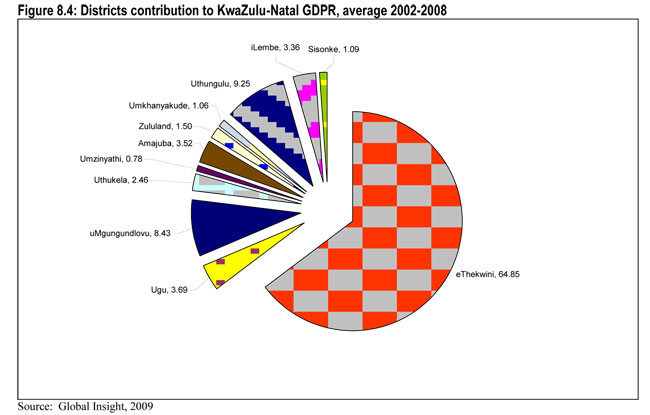
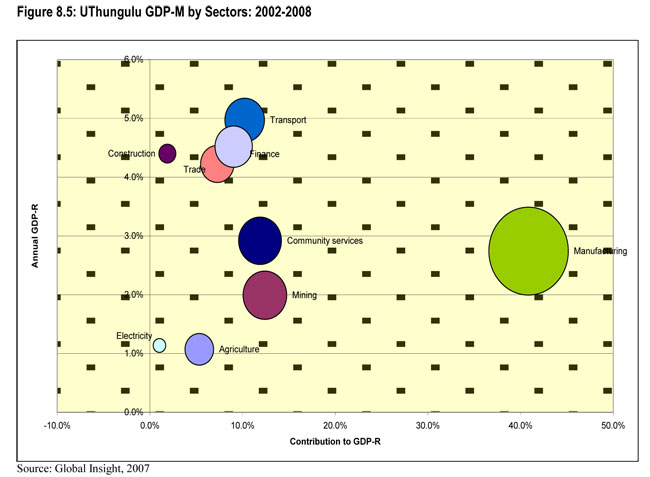

The labour force and the economically active population
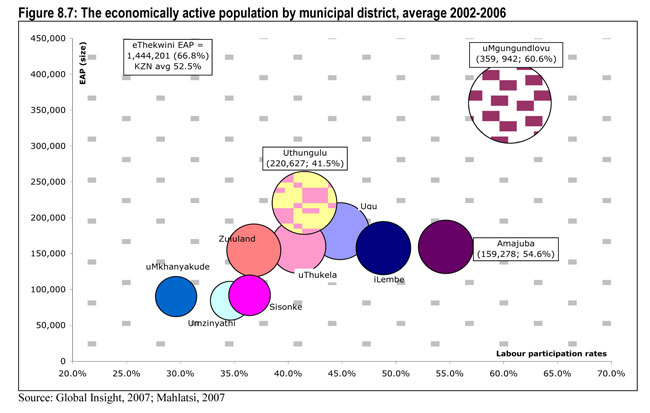
Figure 8.8 gives the average unemployment rates (the unemployed as proportion of the EAP) in the districts between 2002 and 2006. It transpires from the graph that although uThungulu has a lower labour participation rate than Amajuba (Figure 4.7), the former fails to absorb even the few people that are readily available for work; the average unemployment rate for uThungulu was 46.8 percent against 45.4 percent for Amajuba. This is a serious condition and needs probing and appropriate correction.
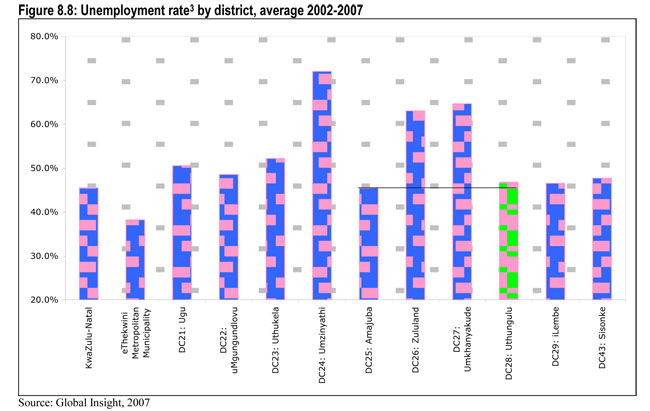
3 Expanded definition; includes those unemployed but not actively seeking a job.
Total employment
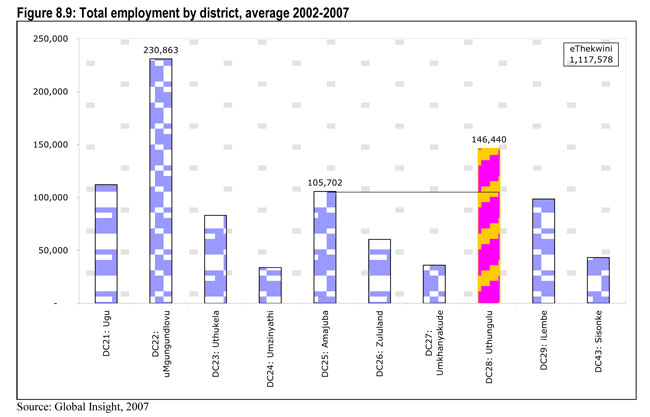
Formal employment
Figure 8.10 also reveals why Amajuba has been able to absorb its labour force faster than uThungulu; the district had the lowest formal employment share to its total employment (64.4%).
The formal employment sector in uThungulu was quite ‘balanced’ between the five major employing economic sectors (Community Services4, Manufacturing, Agriculture, Finance and Trade). The district’s Community Services was the biggest employer (22.1%), followed by Manufacturing (19.9%), Agriculture (13.8%) and Trade (9.9%). The least contributors to formal employment were Electricity (0.7%) and Construction, Mining (4.5 percent each).
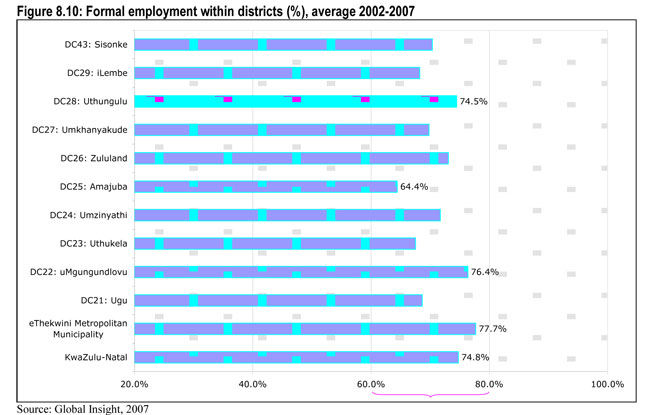
4 This was the most dominant sector in all the districts except eThekwini, Amajuba, iLembe and Sisonke. In fact, in all the districts, it was one of the two leading sectors with either Manufacturing or Agriculture.
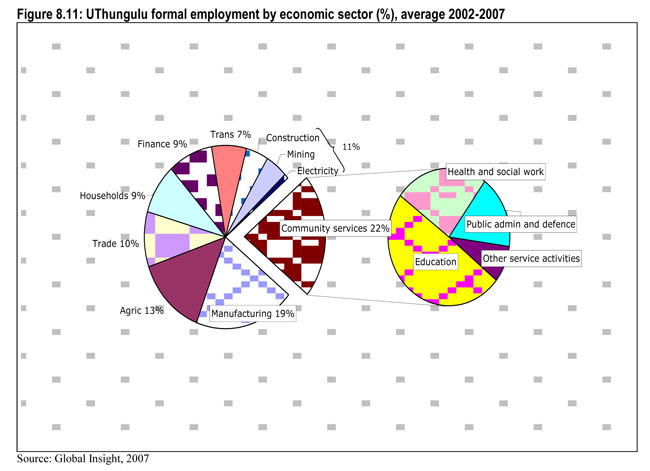
Informal employment
5 An unfortunate hindrance is the absence of detailed data on this issue.
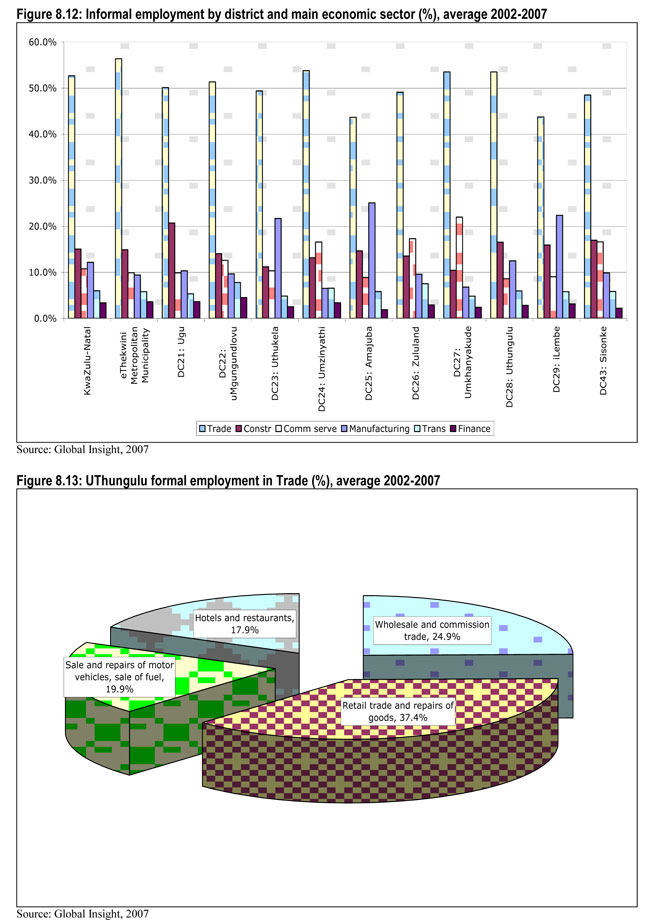
Crime
However, 2003 forwards have seen a similar experience, though with differing magnitudes. The provincial collapse rate in crime was 5.1 percent, while uThungulu’s respective figure was 4.1 percent; this was the third lowest achievement after eThekwini and iLembe.

Land Cover and Use
KwaZulu-Natal’s land size is 93,378 km2 (approximately 8 percent of the South African land). UThungulu’s
size is about 9 percent of this; the sixth largest cover after Zululand (15.9%), uMkhanyakude (13.7%),
uThukela (12.1%), Sisonke (11.9%) and uMgungundlovu (9.6%).
UThungulu’s largest share of the land is covered in unimproved grasslands, followed by thicket & bushland. The
important ‘cultivated’ and ‘forest’ coverages are relatively small (Figure 8.15).

Social Development
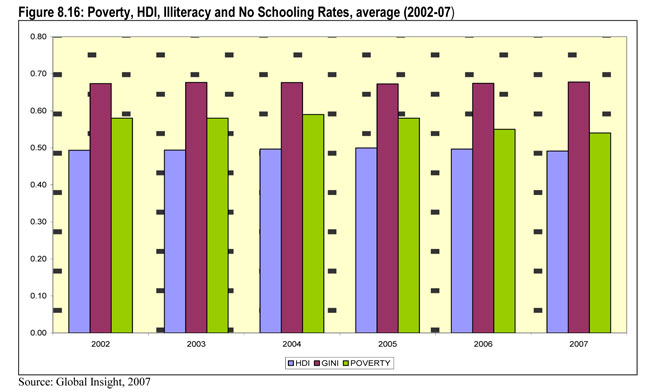
The relatively low poverty rate (although still at 50s) with high level of household income and high rate of no schooling in uThungulu suggests that there may be more number of uneducated self-employed people in the district. Hence, if empowered through education and skills development, one would be able to see a greater reduction in the number of the poor living in this district.
Contact Details
- MM: Mr B B Biyela
Private Bag X 1025 Richards Bay 3900
UThungulu House Kruger Rand
UThungulu House Kruger Rand
Fax: 035 789 1641 / 035 789 1409
E-mail: sceo@uthungulu.co.za
rheedersc@uthungulu.co.za Website: www.uthungulu.org.za
| Local Municipality | Telephone | Facsimile | |
|---|---|---|---|
| Mbonambi | 035 580 4963 / 1421 | 035 580 1141 | nkosim@mbonambi.co.za |
| UMhlathuze | 035 907 5000 | 035 907 5444 / 51 | sibekonj@richemp.org.za |
| Ntambanana | 035 792 7093 | 035 792 7094 | mngunir@ntambanana.org.za hlophes@ntambanana.org.za |
| Umlalazi | 035 473 3474 | 035 474 4733 | simon@umlalazi.org.za Khosi@umlalazi.org.za |
| Mthonjaneni | 035 450 2082 | 035 450 3224 | meltlc@mweb.co.za mmsec@mthonjaneni.org.za |
| Nkandla | 035 833 2000 | 035 833 0920 | mngonyama@nkandla.org.za mngonyama@nkandla.org.za |
Other Projects
The government projects are the responsibility of each respective government department, therefore TIKZN is not responsible for the updating of this information. For further assistance, kindly contact the department responsible directly. Follow this link for available projects:
http://www.kwazulunatal.gov.za
GALLERIES
Despite the fact that KwaZulu-Natal covers such a small portion of South Africa's land area, a significant percentage of the country's small-scale farmers are based here. Agriculture in KwaZulu-Natal is extremely diverse and is reflected in the patterns of its topography. Most of the world's agricultural activities can be practised here. Due to the good reliable rainfall and fertile soils, the region's agricultural sector has become very productive, and is known for its specialist capability in several types of farming. The Province has a total of 6.5 million hectares of land for farming purposes of which 82% is suitable for extensive livestock production and 18% is arable land.

Types of Agriculture
The agricultural sector is focused mainly on the following:
Crops: Sugar, Maize
Horticulture: Sub-tropical fruits especially pineapples and bananas, Cashew nuts, Potatoes, Vegetables
Animal Husbandry: Beef, Sheep (mutton and wool), Pigs, Poultry
Forestry: SA Pine, Saligna, Black Wattle, eucalyptus, poplar,
There is tremendous potential for agricultural expansion in KwaZulu-Natal. It has been conservatively
estimated that if the agricultural natural resources were optimally managed, the present production yield
could be increased dramatically, thus unlocking the full agricultural production potential of KwaZulu-Natal.

Social Programmes
The social programs and the government/private sector joint projects that have been facilitated and implemented by the sugar industry bear testimony to the industry's conscious commitment to the socio-economic and welfare upliftment of its employees. The key challenge for the sugar cane industry remains the maintenance of competitiveness in relation to other world-class producers and industries.
Contact Details
- Mr Vacant Vacant
- Sector Manager
- Knowledge Management
- 1 Arundel Close, Durban, KZN, 4001
- +27 31 368 9600
- Contact Mr Vacant Vacant
